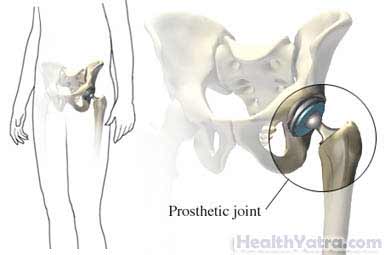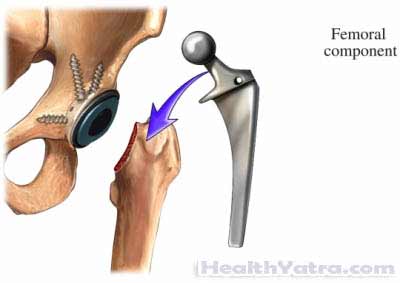সংজ্ঞা
A total hip replacement is a surgery to replace a diseased or injured hip joint. An artificial ball-and-socket joint is inserted to make a new hip.
A minimally invasive total hip replacement is also a surgery to replace a diseased or injured hip joint. This surgery only requires one or two tiny incisions and special instruments. People eligible for this surgery are typically:
- Younger than 50
- Of normal weight
- Healthier than those who have the traditional total hip replacement surgery

পদ্ধতির কারণ
This surgery is done when pain and stiffness limit your normal activities. This pain and stiffness is usually due to osteoarthritis. Surgery is done when other treatments have been tried and are no longer working. These other treatments include rest, medicine, and physical therapy.
Other reasons for surgery may include a broken hip, rheumatoid arthritis, bone tumors, and loss of blood supply to the bones of the hip.
সম্ভাব্য জটিলতা
If you are planning to have a hip replacement, your doctor will review a list of possible complications, which may include:
- Hip dislocation, which is the most common complication—occurs when the ball portion of the prosthesis dislocates from its normal position in the hip
- সংক্রমণ
- রক্ত জমাট
- ফোলা বা রক্তপাত
- Injury to nearby nerves or blood vessels
- Anesthesia-related problems, like pneumonia
- Noisy or squeaky hip after surgery
জটিলতার ঝুঁকি বাড়াতে পারে এমন কারণগুলির মধ্যে রয়েছে:
- Pre-existing medical condition, such as heart or lung problems
- স্থূলতা
- Infection, such as urinary tract infection or gum disease—Having an infection increases the risk of bacteria entering the bloodstream and infecting the joint.
- Previous problems with blood clots
- ধূমপান
অস্ত্রোপচারের আগে আপনার ডাক্তারের সাথে এই ঝুঁকিগুলি নিয়ে আলোচনা করতে ভুলবেন না।
কি আশা করা যায়
পদ্ধতির আগে
আপনার ডাক্তার নিম্নলিখিত করতে পারেন:
- শারীরিক পরীক্ষা
- এক্স-রে
- রক্ত পরীক্ষা
- ম্যাগনেটিক রেজোন্যান্স ইমেজিং (MRI) স্ক্যান
- কম্পিউটেড টমোগ্রাফি (সিটি) স্ক্যান
In the time leading up to the procedure:
- Try to lose weight if you are overweight. This will decrease the amount of stress on your new joint. Pool exercise may be a good option.
- To enhance safety and recovery, make home modifications:
- Install safety bars, a raised toilet seat, a shower bench, and a hose. Install handrails on stairways and steps.
- Remove throw rugs. Check to make sure extension cords are in a safe place.
- Purchase a stable, firm-backed arm chair. When seated, your knees should remain lower than your hips.
- Buy items to make daily activities easier, such as reachers and dressing aids.
- Place items so that they are easy to reach. This way, you will be able to avoid bending.
- আপনার ওষুধ সম্পর্কে আপনার ডাক্তারের সাথে কথা বলুন। পদ্ধতির এক সপ্তাহ আগে আপনাকে কিছু ওষুধ খাওয়া বন্ধ করতে বলা হতে পারে, যেমন:
- প্রদাহ বিরোধী ওষুধ
- রক্ত পাতলা করে
- Your doctor may suggest donating your own blood for the surgery. You will most likely lose some blood and fluid during this surgery. If you need a blood transfusion, the doctor can use your own blood.
- If you become sick or have a fever just before the surgery, tell your doctor right away.
- Arrange for a ride to and from the hospital. Also, arrange for help at home.
- If you smoke, try to smoke less or stop smoking.
- Eat a light meal the night before the surgery. Do not eat or drink anything after midnight. If you have diabetes, ask your doctor if you will need to adjust your medicine.
এনেস্থেশিয়া
সাধারণ এনেস্থেশিয়া ব্যবহার করা হবে। এটি যেকোনো ব্যথাকে অবরুদ্ধ করবে এবং সার্জারির মাধ্যমে আপনাকে ঘুমিয়ে রাখবে। এটি আপনার হাতে বা বাহুতে একটি IV এর মাধ্যমে দেওয়া হয়।
পদ্ধতির বর্ণনা
মোট হিপ প্রতিস্থাপন
An incision will be made along your joint. The muscles will be moved aside. The damaged bone and cartilage of the hip joint will be removed. The remaining bone will be prepared for the prosthesis. The new artificial joint will be placed in position. Depending on the type of prosthesis, the doctor may use bone cement to hold one or both parts of the artificial hip firmly to your bone. Lastly, the incision will be closed with stitches or staples.
Minimally Invasive Total Hip Replacement
This surgery may be done with one or two small incisions. Special tools are used that fit into these small incisions. In some cases, x-rays will be used to help guide the doctor.
For the one-incision surgery, an incision will be made over the outside of your hip. The muscles and tendons will be moved out of the way. Next, the damaged bone and cartilage of the hip joint will be removed. The remaining bone will be prepared for the prosthesis. The new artificial joint will then be placed in position. Depending on the type of prosthesis, bone cement may be used to hold the artificial hip in place. Lastly, the incision will be closed with staples or stitches.
In a two-incision surgery, an incision will be made over the groin and another over

কতক্ষণ এটা লাগবে?
- Total hip replacement: 1-1½ hours
- Minimally invasive total hip replacement: 1 or more hours
এটা কতটা আঘাত করবে?
You will have pain after the surgery. Pain medicine will be given to help with discomfort.
গড় হাসপাতালে থাকার
This procedure is done in a hospital setting. The usual length of stay is:
- 4-6 days for a total hip replacement
- 1-2 days for minimally invasive total hip replacement
Your doctor may choose to keep you longer, if complications occur. In some cases, you may need to stay in a rehabilitation unit. The focus will be on regaining function.
পোস্ট-প্রক্রিয়া যত্ন
হাসপাতালে
While you are recovering at the hospital, you may need to:
- Walk with help, using a walker, on the day after surgery.
- Be careful. A fall can damage or dislocate the new joint. Do not try to walk without help.
- Take medicine to prevent blood clots.
- Wear compression boots or stockings.
- Begin physical therapy to regain mobility and strength.
- Breathe deeply and cough 10-20 times every hour—This will decrease the risk of fluid build-up in the lungs. The fluid can cause pneumonia.
ঘরে
আপনি যখন বাড়িতে ফিরে আসবেন, একটি মসৃণ পুনরুদ্ধার নিশ্চিত করতে নিম্নলিখিতগুলি করুন:
- কাটা জায়গাটি পরিষ্কার এবং শুকনো রাখুন।
- কখন গোসল করা, গোসল করা বা জলে ভিজানো নিরাপদ সে সম্পর্কে আপনার ডাক্তারকে জিজ্ঞাসা করুন।
- When seated, place a V-shaped pillow between your legs. This will help you to maintain correct positioning of your hip.
- Work with the physical therapist. You will learn how to move your hip and maintain proper alignment. You should also talk to your doctor and physical therapist about ways to prevent dislocations. Depending on your surgery, you may need to avoid crossing your legs, flexing your hips more than 90 degrees, and turning your feet very far inward or outward.
- Only take medicines recommended by your doctor. Do not take over-the-counter remedies without your doctor’s approval.
- Inform your dentist of your surgery. You may need antibiotics for some dental procedures. This will decrease the risk of bacteria entering the bloodstream and traveling to the prosthesis.
- Maintain a healthy weight. Obesity can increase wear on your new joint.
- Avoid jogging and other high-impact sports. This can also increase wear on the joint, cause it to loosen, and cause pain.
- আপনার ডাক্তারের নির্দেশাবলী অনুসরণ করতে ভুলবেন না।
Within six weeks, you should be able to resume normal, light activities. A replacement hip typically lasts 10-15 years.
আপনার ডাক্তারকে কল করুন
আপনি হাসপাতাল ছেড়ে যাওয়ার পরে, নিম্নলিখিতগুলির মধ্যে যেকোনটি ঘটলে আপনার ডাক্তারের সাথে যোগাযোগ করুন:
- জ্বর এবং ঠাণ্ডা সহ সংক্রমণের লক্ষণ
- Redness, swelling, increasing pain, excessive bleeding, or discharge around incision site
- Pain and/or swelling in the feet, calves, or legs
- কাশি, শ্বাসকষ্ট, বুকে ব্যথা
- মারাত্মক বমি বমি ভাব বা বমি হওয়া
- Hip pain that you cannot control with the medicines you have been given or that becomes worse
- Numbness, tingling, or loss of feeling in your leg, knee, or foot
জরুরী পরিস্থিতিতে, অবিলম্বে চিকিৎসা সহায়তার জন্য কল করুন।
